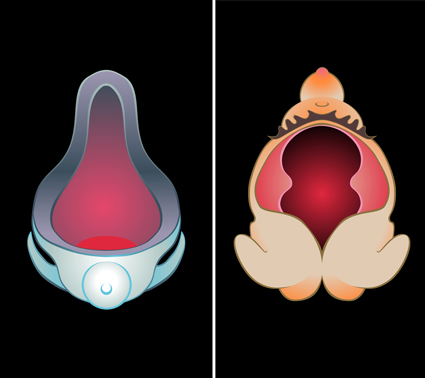 |
Colour Me Dead—Chapter 5: The Hungry Vagina (animation frame/s), 2013 courtesy the artist and Anna Schwartz Gallery |
The six works comprising Colour Me Dead parallel the first six chapters of a forthcoming book by Brophy, and indeed, can be ‘read’ as a logical, even educative, sequence. The first work, The Illuminated Nymph, introduces Brophy’s research, which has entailed forensic exploration of over 3,000 artworks. On the wall panel, 15 reference works are reproduced in small monochrome images—from Fuseli’s The Nightmare (1781) to Victor Brauner’s Nude and Spectral Still Life (1939). On a large circular screen, sketched sepia-toned renderings of the original paintings are the backdrop for cartoon versions of their bright-white female subjects, which morph into radiating spines of light, ultimately shattering. Brophy describes them as “flayed; the flesh is stretched and then pinned on a board.” Their transformation suggests both erasure and glorious ascension, too, as they transform into pure absence/pure light.
The Lady in the Lake again refers to a series of canonic artworks, this time revisiting the ‘woman-water equation.’ Four digital prints are bathed in refracting light like the surface of a pond. In each, a central nude stands in one swirling pool or another, flanked by accomplices or scenes of destruction. The first is Venus-like; the second, a siren; the third, a horrifying ghoul; the fourth, surrealist, truncated at the knees. It’s a path from allure to entrapment to the supernatural, with amputation as full stop.
In The Morbid Forest, the same premise applies to the moving image. The darkly sublime Romantic landscape is re-imagined in disconnected scenes, whose contents alarm by virtue of their juxtaposition. Two men dressed in black and camo-pattern stand in various bush locations; their passivity is menacing. Wraith-like females play ring-a-rosy, a child plays in fairy costume, a couple places a flower tribute at a deserted roadhouse. The sense of imminent threat is strong; and the connection between predatory, misogynist culture and the violence lurking in the artistic canon gains momentum.
In The Hungry Vagina, a triptych of deliciously lurid, animated abstractions—now focusing on the literal or symbolic vagina rather than the ‘whole’—open, close and mutate, accompanied by sticky, smacking, sucking sounds. It’s become a game of spot-the-reference (is that Duchamp’s urinal?). In The Sexualised Chimera, ‘pretty’ turns to ‘ugly’ as Brophy creates mock-up 60s-style ‘monster car’ designs: flaming, wheel-spinning mean machines possessed by cackling, claw-nippled or eyeball-popped Medusas and Judiths. In the catalogue Brophy points to “bong shops and heavy metal album covers,” where these hysterical “vulgar monsters” of Thanatos and Eros exist today. With these works I feel myself ‘buying in,’ embracing the aesthetic for better or worse. The threads seem to draw together, producing a bigger, blurrier whole.
I’m often troubled by the replication of sexist tropes in the name of illumination—all too easily it can seem like more of the same: same vagina-dentata, same conflation of woman/sex/death/nature, same monster-feminine. At times I experience this feeling, reluctantly, with Colour Me Dead. I embrace the work and the thesis with enthusiasm and yet find myself wondering, ‘Hang on, don’t we know this inside-out by now?’ I hunger (that ‘hungry vagina’ again, perhaps) for something more irreducible, disturbing, unsettling. It’s a deliberate strategy, Brophy says, to say it like it is (quoting, as it were): he invites the viewer, “to see…or not to see” the sexual violence that exists across the cultural gamut. Perhaps for the male viewer, this invitation might ‘prick’ a little more, hitting that disturbing pitch.
In The Prostrate Christ, Brophy’s narrative seems to reach that more subtle, complex space. A floor-projected video viewed from a platform features two artists’ models posing to replicate dead Christs, pietàs and prostrate figures, aided by two assistants. Echoing The Illuminated Nymph, the original paintings appear as backdrops, here projected behind the models. Brophy comments that the models were instructed to be ‘in control,’ even while being manipulated into position by the assistants. This results in a distinct uncanniness, as process, ‘nude’ and ‘person’ placed on the same plane, inextricable—‘de-composing’ in more ways than one. It’s a moment of relief: a discreet, plain wrapping that completes by allowing a more prosaic story—a space both within and without history, where the nude finally breathes.
Philip Brophy, Colour Me Dead; Ian Potter Museum of Art, University of Melbourne, 13 June- 8 September
RealTime issue #116 Aug-Sept 2013 pg. 54
© Urszula Dawkins; for permission to reproduce apply to [email protected]








 back
back